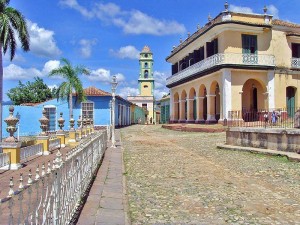TRINIDAD CITY, CUBA: THE CUBAN MUSEUM”. VIDEOS.
Located in the central province of Sancti Spiritus, the formerly known as Villa of the Holy Trinity had its origin in 1514, to be among the first seven villages founded by the Spanish in the Cuban archipelago.
Also called the City Museum of Cuba, has the privilege of being one of the country’s colonial cities and also qualifies among architectural complexes and preserved the Americas.
Declared a World Heritage Site by UNESCO in 1988 and a must in the conquest of new territories, settled along the banks of the river Guaurabo, where the Spanish found an aboriginal population used as labor, fertile land and excellent ports to order picking.
A true treasure of the most varied wealth, the village expanded in the sixteenth century to the incipient sugar industry to grow as an urban nucleus of unique bars, beautiful buildings and cobblestone streets.
Colonial houses, spacious, comfortable and airy palaces where luxury and extravagance made their own to join the Cuban colonial art, turn Trinidad into an undisputable urban and architectural jewel of yesteryear.
The decorative sign characteristic of the homes of the city is based on the neoclassical ornamentation reflected in murals, frames, wooden frames and in the whimsical forms that iron forgers managed to impart, to become one of the great charms city.
In the Plaza Mayor, the core of the old village, stands a statue of Terpsichore, muse of dance and music, accompanied by the unique beauty of the church of the Holy Trinity, faithful guardian of valuable religious treasure the island. These include the Christ of the True Cross, attached to a marble altar dedicated to the cult of the Virgin of Mercy, the only of its kind in the country.
The Valley of the Sugar Mills—Valle de los Ingenios, also a World Heritage Site, has around 70 historic sugar mills. They represent the importance of sugar to the Cuban economy over the centuries. It has la Torre Iznaga, a 45 metres (148 ft) tower built by Alejo Iznaga Borrell in 1816.
The Santa Ana and Tres Cruces, the bell tower of San Francisco and numerous palaces bring a unique beauty to the city, which annually spent enormous efforts to the conservation of ancient buildings located therein.
Among the most important buildings is the Palace of Count Brunet, now houses the Museo Romantico, whose first owner was also linked with the construction of a theater that bore his name and commissioning of a railway between the city and the Port Casilda.
In the 14 rooms of the museum are pieces of decorative arts, including porcelain and glassware, rich polychrome paintings and gold lines, many of which were directly ordered from European manufacturers of the time.
Among the most important properties is also Cantero Palace, with three floors and a gazebo, while Borrell which is famous for the paintings on their walls.
LA CIUDAD DE TRINIDAD, CUBA : “MUSEO DE CUBA”. VIDEOS.
Ubicada en la central provincia de Sancti Spiritus, la antaño conocida como Villa de la Santísima Trinidad tuvo su origen hacia el 1514, para colocarse entre las siete primeras villas fundadas por los españoles en el archipiélago cubano.
También llamada la Ciudad Museo de Cuba, tiene el privilegio de ser una de las localidades coloniales del país y califica además entre los conjuntos arquitectónicos más completos y conservados del continente americano.
Declarada Patrimonio de la Humanidad por la UNESCO en 1988 y ruta obligada hacia la conquista de nuevos territorios, se asentó junto a las márgenes del río Guaurabo, donde los españoles encontraron una población aborígen utilizada como mano de obra, tierras fértiles y excelentes puertos para la preparación de expediciones.
Verdadero tesoro de las más diversas riquezas, la villa extendió sus límites en el siglo XVI, apoyada en la incipiente industria azucarera, para crecer como un núcleo urbano entre rejas de singulares formas, llamativas edificaciones y calles empedradas.
Casonas coloniales, amplias, cómodas y ventiladas, palacios donde el lujo y el derroche hicieron de las suyas para integrarse al arte colonial cubano, convierten a Trinidad en una indiscutible joya urbanística y arquitectónica de antaño.
El signo decorativo característico de las viviendas de la ciudad tiene su base en la ornamentación neoclásica, reflejada en murales, molduras, marcos de madera y en las caprichosas formas que los forjadores del hierro lograron imprimirle, para que se convirtiera en uno de los mayores encantos de la ciudad.
En la Plaza Mayor, eje central de la antigua villa, se localiza una estatua de Terpsícore -musa de la danza y la música-, acompañada de la singular belleza de la iglesia de la Santísima Trinidad, fiel guardián de valiosas piezas del tesoro religioso de la isla. Entre ellas se incluyen el Cristo de la Vera Cruz, unido a un altar de mármol dedicado al culto de la Virgen de la Misericordia, único de su género en el país.
Las plazas de Santa Ana y de las Tres Cruces, el Campanario de San Francisco y numerosos palacetes aportan un toque de belleza única a la ciudad, la cual dedica cada año enormes esfuerzos a la conservación de las edificaciones centenarias que en ella se localizan.
Entre los inmuebles de mayor relevancia esta el Palacio del Conde Brunet, actual sede del Museo Romántico, y cuyo primer propietario estuvo también vinculado con la construcción de un teatro que llevó su nombre y la puesta en marcha de un ferrocarril entre la urbe y el puerto de Casilda.
En las 14 salas del museo se exponen piezas de artes decorativas, entre ellas porcelanas y cristalería, ricas en pinturas policromadas y líneas doradas, muchas de ellas encargadas directamente a fábricas europeas de la época.
Entre los inmuebles de mayor importancia también esta el palacio de Cantero, con tres pisos y un mirador, mientras el de Borrell atribuye su fama vinculada a los cuadros pintados en sus paredes.
Agencies/Wiki/DTCuba/Internet Photos/Arnoldo Varona/thecubanhistory.com
THE CUBAN HISTORY, HOLLYWOOD.








